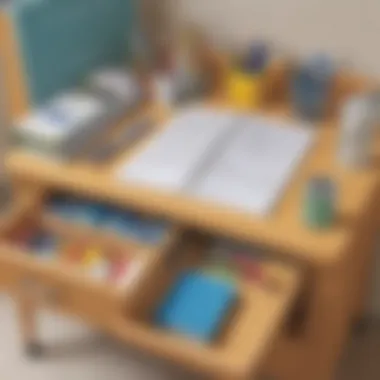Effective Procedures for Entering the Classroom: A Comprehensive Guide


This article delves into the essential procedures for entering a classroom effectively, ensuring a smooth transition and organized beginning for both educators and students. Starting a classroom session sets the tone for the rest of the learning experience, making it imperative to establish a structured and efficient entry routine.
Establishing Entry Protocols
The first step in the classroom entry process involves setting clear protocols for students to follow upon entering. This may include assigning specific areas for belongings, establishing a morning routine, and outlining expectations for behavior and preparedness. By implementing consistent entry protocols, teachers can create a sense of order and predictability, promoting a focused and conducive learning environment.
Greeting and Transitional Activities
Once students have entered the classroom, teachers can facilitate a smooth transition by warmly greeting each student. Utilizing interactive activities or short engaging tasks can help channel students' energy towards productive and focused behavior. These transitional activities can range from quick icebreaker questions to reflective journaling prompts, encouraging students to mentally prepare for the upcoming lesson.
Seating Arrangements and Materials Preparation
Strategically planning seating arrangements can enhance classroom engagement and dynamic interactions among students. Teachers can consider factors such as group work compatibility, visibility of instructional materials, and proximity to learning resources. Additionally, ensuring that materials and resources are organized and readily accessible can streamline the learning process, minimizing disruptions and maximizing instructional time.
Review and Preview
Before diving into the lesson for the day, incorporating a brief review of previously covered material can help reinforce learning and establish connections between concepts. Similarly, providing a preview of the day's agenda creates a roadmap for students, enhancing their understanding of the upcoming content and learning goals. This practice promotes continuity and coherence in the learning process, fostering comprehension and retention.
Conclusion


Entering the classroom is a critical phase that sets the stage for effective teaching and learning. By implementing structured entry procedures, teachers can cultivate a positive and orderly learning environment, conducive to meaningful engagement and academic success.
Introduction
Entering a classroom sets the tone for the entire learning experience, making it a pivotal moment that influences students' engagement and teachers' ability to impart knowledge effectively. This article delves into the essential procedures for entering a classroom efficiently and seamlessly, providing a detailed roadmap for both educators and learners to follow. Understanding the significance of a structured entry process can enhance classroom management, foster a positive learning environment, and ensure that the academic session commences on a smooth and organized note. It is crucial to realize that the way students enter a classroom can impact their mindset and readiness to learn. By establishing clear guidelines and routines for entry, educators can create a sense of purpose and preparedness among students, eliminating distractions and disruptions that may arise from a chaotic or haphazard entry. Moreover, a well-executed entry procedure sets the stage for focused learning, signaling to students that they are about to engage in a meaningful educational experience.
Preparing for Entry
Arriving Early
Arriving early is a fundamental aspect of preparing for entry into the classroom. This practice not only demonstrates respect for scheduled class timings but also allows individuals sufficient time to settle in, gather their thoughts, and transition into a focused mindset. By arriving early, students and teachers can avoid the stress and rush associated with running late, enabling a calm and composed start to the learning session. Additionally, early arrival provides an opportunity for individuals to review any pre-class materials, ensuring readiness for the upcoming lesson.
Organizing Materials
Organizing materials is another critical component of preparing for entry into the classroom. Efficient organization of essential items such as textbooks, notebooks, writing utensils, and technological devices enables smooth access to resources during the learning session. By arranging materials in an orderly manner, students can streamline their workflow and minimize distractions caused by misplaced or missing items. This practice not only promotes efficiency but also fosters a sense of responsibility and attentiveness towards academic tasks.
Mental Preparation
Apart from physical preparation, mental readiness plays a significant role in ensuring a successful entry into the classroom. Engaging in mental preparation involves focusing one's attention on the upcoming lesson, setting positive intentions, and cultivating a mindset conducive to learning. By mentally preparing for the class, individuals can enhance their receptivity to new information, promote active participation, and maximize their educational experience. This aspect of preparation is instrumental in fostering an environment that values attentiveness, curiosity, and academic engagement.
Approaching the Classroom


Approaching the classroom is a pivotal aspect of the classroom entry process, setting the tone for the learning environment. It encompasses the initial steps taken by individuals as they transition from outside distractions to the focused ambiance within the classroom. An effective approach ensures a smooth transition and cultivates a conducive space for engagement and learning. By emphasizing the significance of approaching the classroom, individuals can mentally prepare themselves to shift their focus towards the upcoming learning activities.
Respecting Personal Space
Respecting personal space within the classroom is paramount for fostering a comfortable and respectful environment. It involves being mindful of physical boundaries and considering the personal comfort of others. Respecting personal space not only promotes a sense of safety and privacy but also demonstrates consideration and empathy towards fellow classmates. By maintaining an appropriate distance and being aware of one's surroundings, individuals can cultivate a positive atmosphere conducive to effective learning and interaction.
Maintaining Quietude
Maintaining quietude in the classroom is essential for minimizing distractions and optimizing concentration levels. Quietude cultivates a serene environment that allows individuals to focus on the instructional materials and tasks at hand. By observing silence during transitions and minimizing noise disruptions, individuals can enhance their cognitive performance and maximize their learning potential. Emphasizing the importance of maintaining quietude instills a sense of discipline and respect for the learning space, creating an atmosphere conducive to academic success.
Greeting Others
Greeting others as part of the classroom entry process establishes a sense of community and rapport among individuals. By acknowledging and welcoming classmates and teachers, individuals can foster positive relationships and create a harmonious learning environment. Greeting others promotes inclusivity and mutual respect, laying the foundation for collaborative interactions and shared learning experiences. Encouraging students to greet each other promotes social skills development and cultivates a sense of belonging within the classroom, enhancing overall engagement and academic performance.
Entering the Classroom
In this article, 'Entering the Classroom' holds pivotal significance as it serves as the initial step towards a productive and organized learning environment. This section delves into the critical aspects related to entering the classroom, emphasizing the importance of establishing a focused and respectful atmosphere right from the start. It lays the foundation for smooth classroom operations and sets the tone for a successful educational experience.
Taking Assigned Seat


Taking an assigned seat is a fundamental component of classroom etiquette and discipline. By adhering to this practice, students not only demonstrate respect for the classroom setting but also signify their commitment to engaging in the learning process. The act of taking one's assigned seat promotes orderliness and minimizes disruptions, contributing to a conducive environment for academic pursuits.
Focusing on Task Ahead
Maintaining a focus on the task ahead is instrumental in optimizing learning outcomes. By centering attention on the educational objectives set for the class session, students can enhance their understanding and retention of subject matter. This focus cultivates a sense of purpose and responsibility, fostering a proactive attitude towards academic pursuits and promoting self-directed learning.
Engaging with Classmates
Engaging with classmates promotes collaborative learning and social interaction within the classroom. By interacting with peers, students can exchange ideas, provide support, and develop interpersonal skills crucial for future success. Building positive relationships with classmates creates a supportive learning community and enhances the overall classroom experience, enriching educational outcomes for all individuals involved.
Setting Up for Learning
In the context of classroom procedures, setting up for learning plays a pivotal role in establishing a conducive environment for educational engagement. It serves as the foundation upon which the rest of the learning process is built, ensuring that students have all the necessary resources at hand to maximize their educational experience. By prioritizing the setup phase, educators can set a tone of preparedness and focus for the upcoming instruction.
When considering the importance of setting up for learning within the scope of this article, it is essential to delve into the specific elements that contribute to this process's efficacy. By meticulously organizing materials and resources, students are better equipped to transition smoothly into the learning phase, eliminating unnecessary disruptions and delays that may impede the educational progress. The deliberate act of setting up for learning not only cultivates a sense of responsibility and organization among students but also signifies the value placed on education and active participation within the classroom.
Moreover, the benefits of emphasizing this preparatory phase extend beyond mere logistics. In nurturing a culture of readiness and attentiveness, educators can foster a heightened sense of engagement and enthusiasm for learning among students. By instilling the habit of conscientious preparation, learners are encouraged to approach their academic endeavors with diligence and commitment, thereby enhancing the overall quality of the educational experience.
Considering the importance of setting up for learning within the broader context of classroom management, it becomes apparent that meticulous attention to detail in this initial stage can significantly impact the productivity and efficiency of the entire instructional process. By prioritizing the setup for learning, educators pave the way for seamless transitions between activities and lessons, promoting a sense of continuity and purpose throughout the academic day.
Conclusion
Key Points Discussed
Relevance of the Topic
The relevance of the topic lies in its ability to establish a conducive learning atmosphere that cultivates respect, concentration, and camaraderie among students. Mastering the art of entering the classroom can lead to reduced disruptions, increased focus, and a positive mindset for both educators and learners. It sets the stage for a successful academic journey by promoting accountability, preparedness, and interactive participation within the classroom setting.















